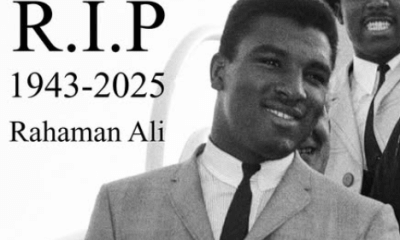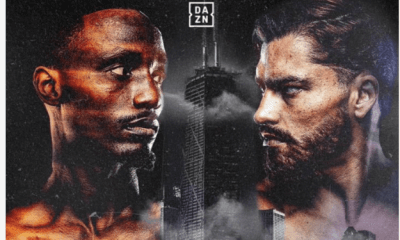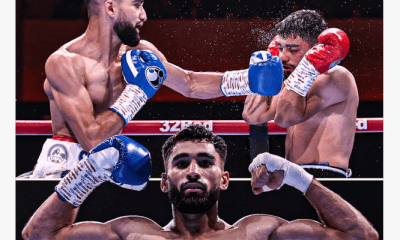Featured Articles
Congrats to AJ, But Fat Andy Obliged His Redemption by Forgetting History
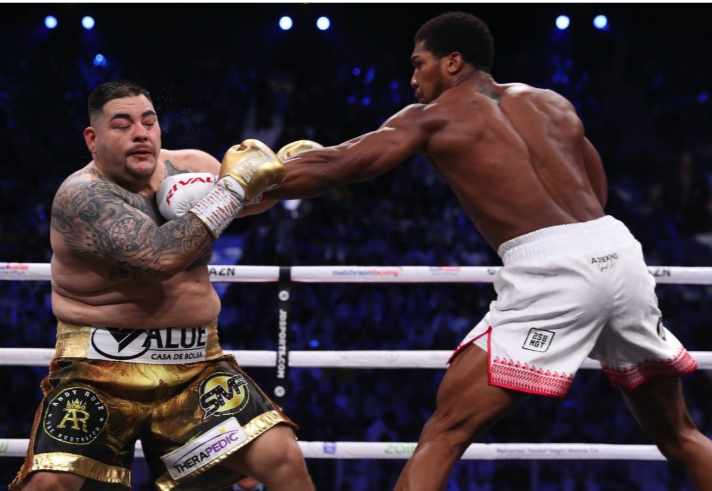
A wise man, Spanish writer/philosopher George Santayana, once observed that those who do not learn history are doomed to repeat it.
All right, so the original quote attributed to Santayana, who was known for aphorisms, was worded slightly differently. But the rationale expressed in either version has remained the same almost forever, and in the specific case of now-dethroned heavyweight champion Andy Ruiz Jr., the closest parallel to the harsh life lesson he learned Saturday evening in Riyadh, Saudi Arabia, took place on Feb. 11, 1990, in Tokyo. Ruiz can be excused for not seeing the HBO telecast of Buster Douglas’ shocking, 10th-round knockout of heavyweight king Mike Tyson on that date because, well, the now-30-year-old Ruiz was still an infant, having been born only 155 days earlier. But you have to figure that by now he’d heard plenty about the most famous upset in boxing history, and how Douglas, the newly crowned champion and momentary toast of the pugilistic world, squandered his opportunity to be something more than a one-hit wonder by getting knocked out in the third round of his first and only title defense, by Evander Holyfield on Oct. 25, 1990, at The Mirage in Las Vegas.
There are, of course, several differences between the cruel price Ruiz must now pay for becoming too self-satisfied with his instant wealth and celebrity, as was the case with Douglas, who never again came within whiffing distance of the form he displayed, boxing-wise or belly-wise, that magical night (well, it was actually Sunday afternoon Tokyo time) in the Land of the Rising Sun.
Douglas went down on his back vs Holyfield and was counted out by referee Mills Lane; the disturbingly chubby Ruiz (33-2, 22 KOs) remained upright for the 12-round distance, but was handily out-boxed from the get-go in losing a wide unanimous decision in his rematch with Great Britain’s Anthony Joshua (23-1, 21 KOs), the man from whom he had lifted the IBF, WBA and WBO belts on a seventh-round stoppage in their first meeting on June 1 of this year in New York’s Madison Square Garden. And while Douglas never did share the ring a second time with Tyson, relinquishing his WBC, WBA and IBF straps to a new opponent, Holyfield, whom he also did not face again, Ruiz’s precipitous fall from grace came in a do-over with Joshua, which may or may not be a precursor to a rubber match that suddenly seems neither assured nor in that much public demand.
“I think I was chasing him too much instead of cutting off the ring,” said the ostensibly 6-foot-2 Ruiz, who officially weighed in at a preposterous 283.7 pounds, or 15.7 more than he did for his successful first go at Joshua, which was widely hailed as boxing’s biggest shocker since Douglas beat up the seemingly invincible Tyson. “I just felt like I couldn’t throw my combinations. But who wants to see a third fight?”
It would have been interesting to see if CompuBox, the punch-counting outfit, could have quickly scanned the sellout crowd of 15,000 in the outdoor stadium on the outskirts of Riyadh to tabulate how many hands went up in support of the possible rubber match that logic almost dictates will never happen. Where Ruiz, a United States citizen and the first heavyweight titlist of Mexican descent, was the taco-tasting flavor of the moment as soon as he had his hand raised against Joshua six months earlier, he now is teetering on the border of irrelevance, just as Douglas was when he demonstrated he did not have the will and discipline to ever again be the same fighter he was in cashing his lottery ticket against Tyson. Ruiz, his considerable girth aside, still has fast hands and decent power for a man his size, but his waddling pursuit of AJ in the Saudi desert now stamps him as little more than a more mobile hippo in a river teeming with faster-moving crocodiles. With Ruiz’s seeming expulsion from the club, what had been a Big Four of heavyweight boxing again has been constricted to a Big Three, with Joshua reclaiming a favored place at the head table along with WBC champion Deontay Wilder (42-0-1, 41 KOs) and humongous Brit Tyson Fury (29-0-1, 20 KOs), who technically remains the lineal champ.
Wilder and Fury are set to square off a second time on Feb. 22 at an undetermined site in a reprise of their classic first matchup, which ended in a controversial split draw on Dec. 1, 2018 at Los Angeles’ Staples Center. Some observers felt that the sharp-boxing Fury had banked enough rounds to get the nod, while dissenters sided with Wilder, who registered two knockdowns, including a 12th-round flooring from which Fury barely beat the count. Whomever survives that showdown automatically becomes the people’s choice to go for the undisputed title against Joshua, unless, of course, there is some sort of undisclosed contractual obligation for Wilder and Fury to swap punches a third time.
Nor is Joshua, who has expressed his desire to fully complete his collection of bejeweled championship belts, likely to voluntarily surrender any to accommodate Ruiz’s entreaties to get it on a third time. The WBO announced immediately after the fight that Joshua must make his mandatory defense against Oleksandr Usyk (17-0, 13 KOs) within 180 days, while the IBF wants AJ to defend against its mandatory challenger, Kubrat Pulev (28-1, 14 KOs). A pairing of Joshua and Usyk, the former undisputed cruiserweight champion who 17-0 with 13 KOs, is of much more global interest than Joshua-Ruiz 3 would be, and the likelihood is that AJ would accede to the IBF’s wishes rather than allow one of his titles to be vacated.
Where does that leave Ruiz? Likely back in the outer waiting room of title contention, where he either can buckle down and prove that he is not Buster Douglas Not-So-Lite by paying some dues to his craft instead of hefty restaurant bills. As Douglas – who ballooned to almost 400 pounds after his retirement from boxing — proved, it is one thing to enjoy living large, but it quite another to allow your appetites to go unchecked.
“It was his night,” Ruiz said of Joshua. “I don’t think I prepared as good as I should have. I gained too much weight, but I don’t want to give no excuses. He won, he boxed me around, but if we did the third (fight), best believe I will come in the best shape of my life.
“(The weight gain, from the 268 he came in for the first meeting with Joshua) kind of affected me a lot. I thought I would come in stronger and better. But you know what? Next time I am going to prepare better with my team. This time I tried to train myself at times, but no excuses. Anthony Joshua did a hell of a job.”
Perhaps a third Joshua-Ruiz bout, if it ever happens, should seek sponsorships from Jenny Craig and Nutrisystem. The subject of weight, both gained and lost, almost superseded more traditional boxing considerations from the time the rematch was announced right through the bell ending the 12th round.
For his part, Ruiz either was in denial or simply lying about the level of his conditioning, which is tied so closely to the number that is displayed on a scale. Even after arriving in Riyadh, he insisted that he expected to come in “around eight pounds” lighter than he had for the first fight with Joshua, an estimation that either was a blatant prevarication or one of the worst miscalculations ever. Despite already having an Adonis-type physique, Joshua had determined that he needed to slim down to increase his mobility and endurance, a goal which appeared to be achieved when he whittled himself from 247.75 pounds for the first fight to 237.8. His reconstructed body more closely resembled that of an Olympic gold medalist swimmer than an Olympic gold medalist fighter. This AJ looked less Lennox Lewis than Michael Phelps, and the boost in his stamina was evident as he pranced around the huge 22-foot ring like a frisky colt for all 12 rounds, peppering Ruiz’s reddened face with stiff jabs, occasional overhand rights and change-of-pace left hooks downstairs.
It will be interesting to see if AJ will retain his sleek, more mobile look when the time comes to get it on with so feared a slugger as Wilder, or as monstrously large a man as Fury. That is another story for another day, and that day is surely coming.
Not so certain is how the saga of Andy Ruiz Jr. transitions to another, perhaps final chapter. With fleshy love handles spilling over the waistband of his trunks like crème filling from a squeezed doughnut, he has never looked the part of an elite heavyweight, but his lumpy appearance belied real skills that might have been even more evident were he to eat to live instead of living to eat. Which brings us back to his predecessor of squandered opportunities, Buster Douglas.
When Douglas beat Tyson – not only beat him, but beat him up – he was inspired to perform at a higher level than ever before by the untimely death of his beloved mother, Lula Pearl Douglas. That motivation, coupled with Tyson’s arrogant belief that he need only to show up and another frightened foe would collapse before him, produced an unexpected outcome that has become the stuff of legend.
Fit as he had ever been at 231 pounds for the Tyson fight, rumors abounded that Douglas was having pizza regularly delivered him in the hotel sauna as he prepped for Holyfield. When the man from Columbus, Ohio, weighed in at a jiggly 246 for a title defense for which he was being paid $24.075 million, hundreds of spectators at the open-to-the-public event literally sprinted from their seats to the casino sports book to get bets down on Holyfield.
That scene, of course, could not be repeated in Riyadh because there is no legalized gambling in Saudi Arabia, although it might have been a kick to see men in flowing white robes and keffiyehs on their heads sprinting toward the nearest sports book, had one existed. And while there is no gambling tolerated in Saudi Arabia, the sale and consumption of alcoholic beverages also is against the law, as is male fraternization with women (most of whom are wrapped up like mummies anyway) who aren’t their wives. In other words, the place is never to become as much a travel destination for fun-seeking Westerners as, say, Vegas, which is why it says here that Riyadh can never become as much of a fight town as the free-spending sheiks and promoter Eddie Hearn might want, despite the fact that Saudi backers ponied up a massive site fee somewhere between $40 million and $100 million to host Ruiz-Joshua 2. Oh, and there’s also that little matter of Saudi Arabia’s authoritarian governmental policies, which might explain why superstar golfer Tiger Woods has steadfastly declined to journey there the past couple of years to play in the Saudi Invitational tournament, despite offers of a $3 million appearance fee regardless of how he fared on the links.
So, we shall see whether Ruiz, a father of five who celebrated his stunner over Joshua by splurging on a mansion and Rolls-Royce, among other shiny new toys, finally reins himself in or continues to drift into the hazy limbo to which Buster Douglas is forever relegated. After Buster was knocked down by Holyfield, and seemed in no particular hurry to get up, the gentlemanly trainer Eddie Futch – who was there as an interested spectator, without any connection to either fighter – lambasted the now-former champion as he almost never did when speaking publicly about anyone.
“Buster Douglas fought a disgraceful fight,” said Mr. Eddie, now deceased. “He allowed himself to get in such poor condition that he had nothing – no snap, not one good punch in three rounds. For the heavyweight champion to come in such condition is just outlandish.”
And this, from Mike Trainer, Sugar Ray Leonard’s longtime attorney and adviser, who was serving as The Mirage’s boxing consultant at that time.
“We break our necks to give the public a great evening and to keep the promise, which is why we have a beautiful stadium. Wynton Marsalis, Sugar Ray Leonard and fireworks. We compliment Evander Holyfield for coming into the ring well-prepared to keep that promise. However, our attitude is that fight purses should be more along the lines of winner-take-all so that the only incentive is victory.”
That isn’t going to happen either, but it does give pause for thought when one of the two participants in a big-ticket fight shows up seemingly not prepared to give his best effort.
Photo credit: Mark Robinson / Matchroom
Check out more boxing news on video at The Boxing Channel
To comment on this story in The Fight Forum CLICK HERE
-

 Featured Articles3 weeks ago
Featured Articles3 weeks agoResults and Recaps from New York Where Taylor Edged Serrano Once Again
-

 Featured Articles1 week ago
Featured Articles1 week agoThe Hauser Report: Zayas-Garcia, Pacquiao, Usyk, and the NYSAC
-
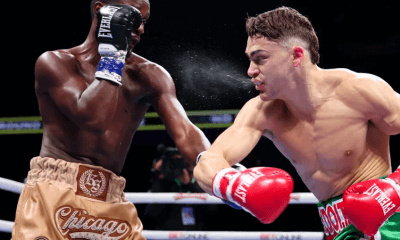
 Featured Articles2 days ago
Featured Articles2 days agoOscar Duarte and Regis Prograis Prevail on an Action-Packed Fight Card in Chicago
-

 Featured Articles3 weeks ago
Featured Articles3 weeks agoResults and Recaps from NYC where Hamzah Sheeraz was Spectacular
-

 Featured Articles4 weeks ago
Featured Articles4 weeks agoFrom a Sympathetic Figure to a Pariah: The Travails of Julio Cesar Chavez Jr
-
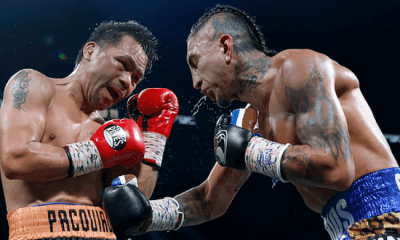
 Featured Articles2 weeks ago
Featured Articles2 weeks agoManny Pacquiao and Mario Barrios Fight to a Draw; Fundora stops Tim Tszyu
-

 Featured Articles4 weeks ago
Featured Articles4 weeks agoPhiladelphia Welterweight Gil Turner, a Phenom, Now Rests in an Unmarked Grave
-
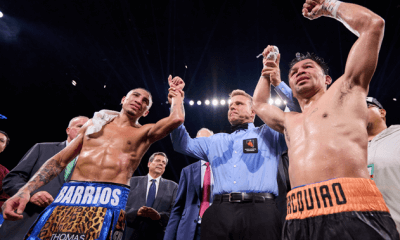
 Featured Articles2 weeks ago
Featured Articles2 weeks agoArne’s Almanac: Pacquiao-Barrios Redux


